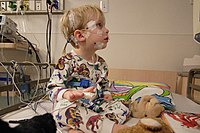
Photo from wikipedia
Sedentary behavior, physical activity (PA), and sleep are health behaviors that contribute significantly to overall and early childhood health. Although interactive relationships of these behaviors have been reported in adults… Click to show full abstract
Sedentary behavior, physical activity (PA), and sleep are health behaviors that contribute significantly to overall and early childhood health. Although interactive relationships of these behaviors have been reported in adults and school-aged children, there is limited evidence that PA is associated with sleep using objective measures in younger children and findings have been mixed. The purpose of this study was to determine if objectively measured PA and sleep behavior outcomes are associated in preschoolers. Participants (n=77, age: 4.34±177;0.91 years; 55.8% female) were included in this cross-sectional study. Actiwatch Spectrum monitors (wrist-worn, triaxial accelerometers) were worn 24-hours for 16-days to measure PA (total PA counts, sedentary time [ST], light PA, and moderate-to-vigorous PA [MVPA]) and sleep (24-hour, nighttime, and nap sleep duration, bedtime, wake after sleep onset [WASO], and sleep efficiency). Multiple linear regression models adjusted for age and wear time during wake periods indicated that greater MVPA was associated with less nighttime sleep duration (β=-3.48, p<0.001), less total 24-hour sleep duration (β=-3.38, p<0.001), and a later bedtime (β=0.07, p<0.001). Total PA counts were associated with less nighttime sleep duration (β=-0.0002, p=0.001), less total 24-hour sleep duration (β=-0.0002, p=0.001), and a later bedtime (β=4.83, p=0.001). Greater ST was associated with greater total 24-hour sleep duration (β=1.92, p=0.006) and an earlier bedtime (β=-0.36, p=0.02). Percent time spent in light PA was not associated with any sleep outcomes and no PA variables were associated with nap sleep duration, WASO, or sleep efficiency. As these findings are in contrast to previous studies reporting null or beneficial associations, further analyses are warranted to examine potential mediators/effect modifiers (e.g., sleep timing, gender, body mass index, and socioeconomic status) and temporal relationships between these movement behaviors in young children. NIH R01 HL111695
Journal Title: Sleep
Year Published: 2020
Link to full text (if available)
Share on Social Media: Sign Up to like & get
recommendations!